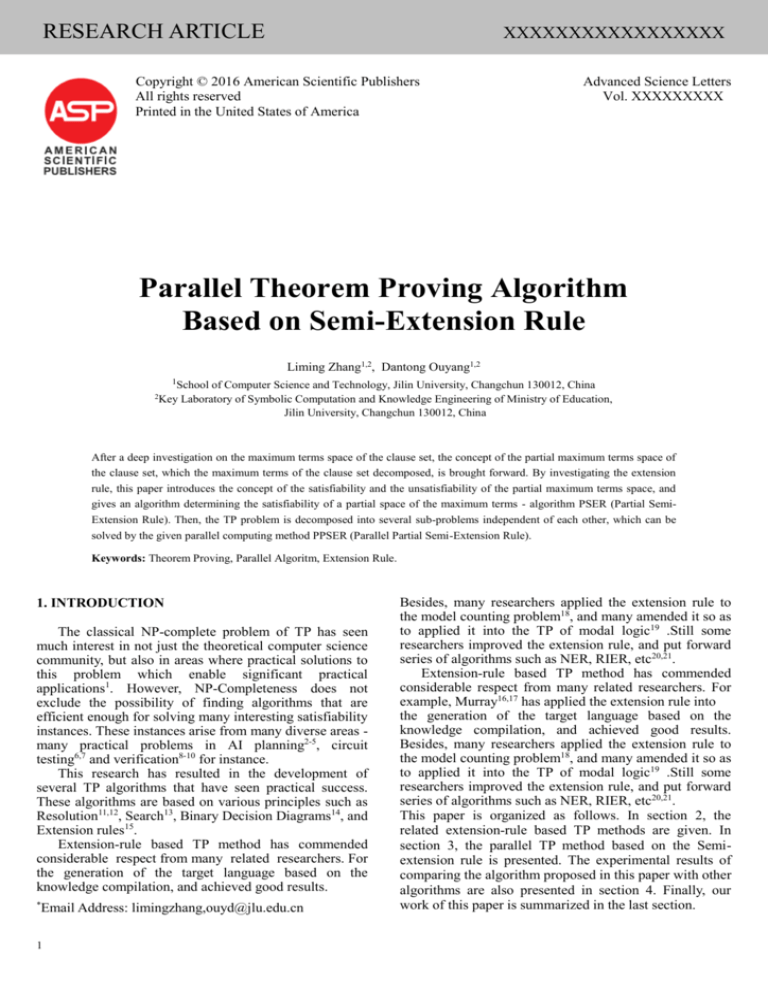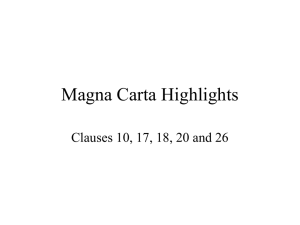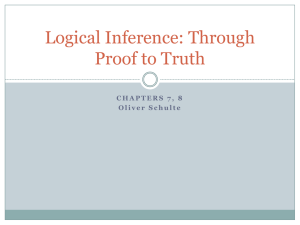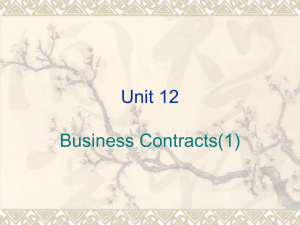
RESEARCH ARTICLE
XXXXXXXXXXXXXXXXX
Copyright © 2016 American Scientific Publishers
All rights reserved
Printed in the United States of America
Advanced Science Letters
Vol. XXXXXXXXX
Parallel Theorem Proving Algorithm
Based on Semi-Extension Rule
Liming Zhang1,2, Dantong Ouyang1,2
1School
2Key
of Computer Science and Technology, Jilin University, Changchun 130012, China
Laboratory of Symbolic Computation and Knowledge Engineering of Ministry of Education,
Jilin University, Changchun 130012, China
After a deep investigation on the maximum terms space of the clause set, the concept of the partial maximum terms space of
the clause set, which the maximum terms of the clause set decomposed, is brought forward. By investigating the extension
rule, this paper introduces the concept of the satisfiability and the unsatisfiability of the partial maximum terms space, and
gives an algorithm determining the satisfiability of a partial space of the maximum terms - algorithm PSER (Partial SemiExtension Rule). Then, the TP problem is decomposed into several sub-problems independent of each other, which can be
solved by the given parallel computing method PPSER (Parallel Partial Semi-Extension Rule).
Keywords: Theorem Proving, Parallel Algoritm, Extension Rule.
1. INTRODUCTION
The classical NP-complete problem of TP has seen
much interest in not just the theoretical computer science
community, but also in areas where practical solutions to
this problem which enable significant practical
applications1. However, NP-Completeness does not
exclude the possibility of finding algorithms that are
efficient enough for solving many interesting satisfiability
instances. These instances arise from many diverse areas many practical problems in AI planning2-5, circuit
testing6,7 and verification8-10 for instance.
This research has resulted in the development of
several TP algorithms that have seen practical success.
These algorithms are based on various principles such as
Resolution11,12, Search13, Binary Decision Diagrams14, and
Extension rules15.
Extension-rule based TP method has commended
considerable respect from many related researchers. For
the generation of the target language based on the
knowledge compilation, and achieved good results.
*
Email Address: limingzhang,ouyd@jlu.edu.cn
1
Besides, many researchers applied the extension rule to
the model counting problem18, and many amended it so as
to applied it into the TP of modal logic19 .Still some
researchers improved the extension rule, and put forward
series of algorithms such as NER, RIER, etc20,21.
Extension-rule based TP method has commended
considerable respect from many related researchers. For
example, Murray16,17 has applied the extension rule into
the generation of the target language based on the
knowledge compilation, and achieved good results.
Besides, many researchers applied the extension rule to
the model counting problem18, and many amended it so as
to applied it into the TP of modal logic19 .Still some
researchers improved the extension rule, and put forward
series of algorithms such as NER, RIER, etc20,21.
This paper is organized as follows. In section 2, the
related extension-rule based TP methods are given. In
section 3, the parallel TP method based on the Semiextension rule is presented. The experimental results of
comparing the algorithm proposed in this paper with other
algorithms are also presented in section 4. Finally, our
work of this paper is summarized in the last section.
Adv. Sci. Lett. X, XXX–XXX, 2016
2. EXTENSION-RULE BASED THEOREM
PROVING METHOD
We begin by specifying the notation that will be used
in the rest of this paper. We use Ψ to denote a set of
clauses in conjunctive normal form (CNF), C to denote a
single clause, and M to denote the set of all the atoms that
appear inΨ. The extension rule is defined as follows.
DEFINITION 115.Given a clause C, C∈Ψ , D
={ CA, CA | “A” is an atom, A∈M, “A” and “A”
does not appear in C}, we call the deduction process
proceeding from C to D the extension rule of on C, and
call D the result of applying the extension rule of on C.
THEOREM 115.A clause C is logically equivalent to
the result of the extension rule D.
This theorem ensured the equivalence between the
original clause set and the expanded clause set, thus
extension rule can be regarded as an inference rule.
DEFINITION 222.A non-tautology clause is a
maximum term on a set M iff it contains all the atoms in
M in either positive form or negative form.
THEOREM 215.Given a set of clauses Ψ, let M be
the set of all the atoms in it (|M|= m). If all the clauses in
Ψ are maximum terms on M, then the clause set Ψ is
unsatisfiable iff it contains 2m clauses.
Apparently the set of all the maximum terms consist
of m atoms is surely contains 2m maximum terms.
Therefore, it is only need to compute the number of
distinct maximum terms can be deduced from the clause
set that we can determine its satisfiability. In addition,
when counting the number of the maximum terms that
can be deduced from the clause set, we can use the
inclusion-exclusion principle presented below.
THEOREM 322.(Inclusion–exclusion principle) The
element number of the union of sets of set A1, A2,…, An
can be compute using the formula below:
n
| A |
i
| Ai Aj |
A1∪A2∪…∪An i 1
1i j n
… n+1
1 A1 A2 … An.
THEOREM 415.The intersection of the sets that
consist of the maximum terms expanded by two clauses
respectively will be empty iff these two clauses contain
complementary literals.
Given a set of clauses ΨC1, C2, … , Cn, let M be
the set of atoms that appear in it (|M|= m).Let Pi be the
sets of all the maximum terms we can get from Ci by
using the extension rule, and let S be the number of
distinct maximum terms we can get from Ψ. By using the
extension rule, we will have SP1∪P2 ∪…∪Pn.
3. PARALLEL PROVING ALGORITHM BASED
ON SEMI-EXTENSION RULE
The idea of the paralleled semi-extension rule based
algorithm is as follows. Firstly, the algorithm decomposes
the maximum terms space of the clause set into several
partial maximum terms spaces, which convert the SAT
RESEARCH ARTICLE
problem of the clause set into the SAT problem of the
partial maximum terms spaces. If there is a certain partial
maximum terms space that is satisfiable, then the clause
set is satisfiable. If all the partial maximum terms spaces
are unsatisfiable, then the clause set is unsatisfiable. In
other words, the clause set is satisfiable. In the following,
the concept of the partial maximum terms space will be
given.
DEFINITION 3. For the set M={L1,L2,…Lm}, the 2m
maximum
terms
corresponding
to
M
is
{L1∨L2∨…∨Lm-1∨Lm, L1∨L2∨…∨LmL1∨L2∨…∨Lm},
1∨Lm,…,L1∨L2∨…∨Lm-1∨Lm,
and
we
number
each
maximum
term
as
m-2
m-1
mi(0),mi(1),…,mi(2 ),mi(2 ).
DEFINITION 4.Given a clause set ΨC1,
C2,…,Cn, let M be the set of its literals, andMm. We
call maximum terms space of M as MI(M). Assuming that
1≤2k≤2m,if we would like to decompose the maximum
terms space into 2k spaces, then each space is of this form
MIS(j)={mi(j)|j∈{ mi(2m×(j-1)/ 2k), mi(2m×(j-1)/2k+1),…,
mi(2m×(j)/ 2k-1)}}, 1≤j≤2k .
DEFINITION 5. For the partial maximum terms
space MIS(j), 1≤j≤2k≤2m. If all the maximum terms in it
can be expanded by the clauses of the clause set, then
MIS(j) is said to be unsatisfiable. If there exist a certain
maximum term that cannot be expanded by any clause of
the clause set, then MIS(j) is said to be satisfiable.
THEOREM 5.If every partial maximum terms space
is unsatisfiable, then the clause set is unsatisfiable. If
there is a certain partial maximum terms space that is
satisfiable, then the clause set is satisfiable.
In the following, the algorithm PSER which
determines the satisfiability of the partial maximum terms
space will be given
DEFINITION 6.
M={L1,L2,…,Lm},m=|M|. Let
clause C= Li∨…∨Lj…∨Ld, 1≤i≤j≤d≤m, which d is
referred as the degree of clause C. Ψ={CLk,
CLk|d<k≤m }, we call the operation proceeding from C
to the elements of Ψ the semi-extension rule, and the
elements of Ψ the result of the semi-extension rule.
PROPOSITON 1.According to definition 6, when
applying the semi-extension rule on C, the remaining m-d
atoms could be positive or negative, therefore C can semiexpand 2m-d clauses.
PROPOSITION 2.Let d1 and d2 be the degrees of
clause C1 and C2 respectively, while d1<d2 and C1 C2.
According to proposition 1, the clause that C1 or C2 can
semi-expand is obtained by compose the m-d1 atoms or
m-d2 atoms in positive form or in negative form.
Therefore, clauses that C2 can semi-expand are a subset of
the clauses that C1 can expand.
According to proposition 2, when determining
whether the maximum terms clause can be expanded by
the clauses, we should determine whether it can be
expanded by the clauses of smaller degree first. In the
following, the algorithm determining the satisfiability of
the partial maximum terms space will be given.
2
RESEARCH ARTICLE
Function PSER(CNF:Ψ, INT:starti, INT:endi )
1
BEGIN
2
i←starti; Ψ=DegreeSort(Ψ);
3
While(i< endi)
4
BEGIN
5
T←getMaxTerm(i);
6
If Expand(Ψ, T)==false
7
Then Return SAT;
8
Else If (len<m) i=LastMi(C,M)
9
i++;
10
END
11
Return UNSAT;
12 END
In the following, the related theorem and algorithm
of Expand will be given.
THEOREM 621.Given a clause setΨ={C1,C2,…,Cn},
Let M be the set of its literals, and |M|=m. A maximum
term T=L1∨L2∨…∨Lm on M can be expanded by clause
C= Li∨…∨Lj…∨Ld, 1≤i≤j≤d≤m, iff { Li,…,Lj,…,Ld }
{L1,L2,…,Lm}.
In the above, we gave the solving method of partial
maximum terms space and the algorithm determining its
satisfiability. The maximum terms space of a clause set
can be decomposed into several partial maximum terms
spaces. In doing so, the SAT problem of a clause set is
converted into the SAT problems of several partial
maximum terms spaces. If there is a partial maximum
terms space that cannot be expanded, then the clause set
is satisfiable. Or else, if all the partial maximum terms
space is unsatisfiable, then the clause set is unsatisfiable.
In the following, the parallel TP algorithm based on semiextension rule will be given.
Function PPSER( CNF: Ψ, INT:
threadnum)
1
While i < threadnum do
2
BEGIN
3
tid = creatthread ();
4
If ( tid = = 0 )
5
BEGIN
6
Result[i] = PSER(Ψ,
start(i), end(i));
7
exit(0);
8
END
9
i++
10
END
11
While (1) do
12
BEGIN
13
int Count=0;
14
While j < threadnum do
15
BEGIN
16
if (Result[j]==SAT)
17
return SAT;
18
if
(Result[j]==UNSAT)
19
Count++;
20
END
3
XXXXXXXXXXXXXXXXX
21
if (Count==n)
return
UNSAT;
22
END
The concrete flow of the algorithm is as follows: The
parent process distributes Threadnum sub-threads, and
then these sub-threads are arranged to many cores of the
processor by the Operating System, respectively. Each
sub-thread calls the function PSER, and records the
corresponding returned results using Result[j], while the
parent process monitors running result of each sub-thread.
If there is a sub-thread that its Result[j] is SAT, then the
algorithm returns SAT. If the Result[j] of every sub-thread
is UNSAT, then the algorithm returns UNSAT.
4 EXPERIMENTAL RESULT
On the basis of literature 21, in this section, we
compare our algorithm PPSER with algorithm NER,
algorithm IER and Directional Resolution algorithm 12
proposed by Dechter and et al, respectively. The
experiments are carried out on a Dell Dimension C521,
AMD Athlon(tm) 64 X2 Dual Core Processor 3600+,
1.9GHz 1022MB RAM with Windows XP. This
experiment uses Uniform Random-3-SAT benchmark 23
lays on phase change zone and standard test cases of frb
24 as test cases. For the entire 1000 issues of uf20-90,
table 1 only shows the experimental results of 10 issues
randomly selected. The first column of the table shows
the sample name, the latter 3 columns shows the runtime
of three algorithms corresponding to each issue which the
unit of data is Seconds (s). For each test case, we will test
10 times and take the mean value as the experimental
results. As we can see from the test, our algorithm PPSER
has a significant advantage on efficiency compared with
the original algorithm, which is 8-20 times higher than the
relatively fast algorithm NER.
Table.1. Experimental Results of Uniform Random3-SAT Benchmark Instances.
PROBLEM NER(s)
DR(s)
IER(s)
uf20-
0.015
1.938
0.062
uf2002
uf2005
uf2007
0.015
1.359
0.109
0.031
0.781
1.218
0.078
4.797
0.609
uf2009
uf20018
0.078
1.563
6.968
0.046
1.203
0.484
uf20023
uf20036
0.031
1.797
0.313
0.046
1.390
0.453
uf20040
uf20042
0.015
2.343
0.250
0.078
4.000
0.484
First,
069we select instances, which the parameters are
<N,20,10> and <N, 30,10> respectively, for testing, where
the parameter N is restricted as 60 ≤ N ≤ 160. For each
instance of different difficulty levels, they will randomly
generate 10 samples for solving, and let the mean value as
RESEARCH ARTICLE
Adv. Sci. Lett. X, XXX–XXX, 2016
the final result. The experimental result is in Figure 1 and
Figure 2.
Fig.1. <N, 20, 10>
is satisfiable, then the clause set is satisfiable. Besides,
when determining the satisfiability of the partial
maximum terms space, if we found that a maximum term
can be expanded by a certain clause, then all the
maximum terms semi-expanded based on this clause have
no need to determine their expandability, thus effectively
reduced the number of the maximum terms to be
determined. The experiment results show that our
algorithm PPSER has a reasonable execution efficiency,
which is superior to algorithm NER, DR, IER and et al.
ACKNOWLEDGMENTS
This work was supported in part by NSFC under
Grant Nos. 60973089.
REFERENCES
[1]
[2]
[3]
Fig.2. <N, 20, 10>
By testing the Random SAT problems, we can see
from figure 1 and figure 2, that our algorithm PPSER has
an obvious advantage on efficiency, which is 6-15 times
higher than the relatively fast algorithm NER. Moreover,
when the number of clauses increased to 130 above, the
computing time of our algorithm PPSER is increased
gently.
5. CONCLUSIONS
This method decompose the maximum terms space
of the clause set into several partial maximum terms
spaces, and determines the satisfiability of each partial
maximum terms space. If all the partial maximum terms
space are unsatisfiable, the clause set is unsatisfiable. Or
else, if there is a certain partial maximum terms space that
[4]
[5]
[6]
[7]
Massart Thierry, Meuter Cedric, V B Laurent. On the complexity
of partial order trace model checking, Inform. Process. Lett. 106
(2008) 120-126
M. Davis, H. Putnam. A computing procedure for quantification
theory. Journal of ACM, 7(3)(1960) 201-215.
Dechter R, Rish I. Directional resolution: the davis-putnam
procedure. Proceeding of 4th International Conference on
Principles of KR&R, Bonn, Germany: Morgan Kaufmann,
(1994) 134-145.
M. Davis, G. Logemann, D. Loveland, A machine program for
theorem proving. Communications of the ACM, 5 (1962) 394397.
R. E. Bryant. Graph-based algorithms for boolean function
manipulation , IEEE Transactions on Computers, 35 (1986) 677691.
H Lin, JG Sun, YM Zhang. Theorem proving based on the
extension rule, Journal of Automated Reasoning, 31 (2003) 1121.
K Xu, F Boussemart, F Hemery, C Lecoutre. Random constraint
satisfaction: easy generation of hard (satisfiable) instances ,
Artificial Intelligence, 171 (2007) 514-534.
Received: 30 April 2016. Accepted: 30 October 2016
4









